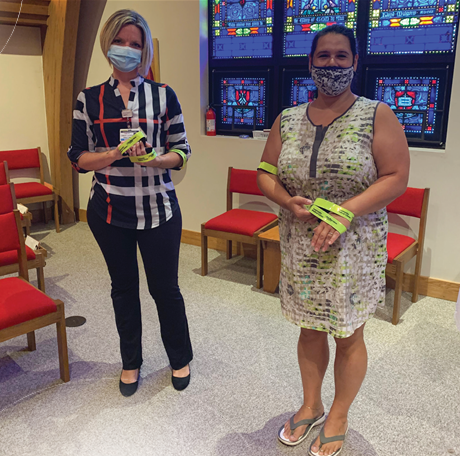Community Medical Center in Toms River, New Jersey distributed reflectors to churches and a community center to reduce the risk of pedestrian injuries in their area.

For Teri Kubiel, DNP, MSN, NE- BC, Vice President of Patient Experience and Community Affairs at Community Medical Center (CMC), pedestrian safety is a subject that’s near and dear to her heart.
From 1963 until 2011, Dr. Kubiel’s father was the Ocean County Traffic Safety Engineer. In this role, he oversaw bicycle and pedestrian safety and promoted the use of helmets and reflectors in Toms River. He was also involved in creating a summer safety program, placing stop signs around town, and developing defensive-driving classes. So, when Dr. Kubiel noticed the growing number of pedestrians in Ocean County, “my dad ‘spoke’ to me,” she says.
Dr. Kubiel and Keri Britske, Director of Community Outreach at CMC, decided to provide the community with reflectors to help ensure their safety. “We wanted to reduce the number of pedestrian injuries and raise awareness of pedestrian safety,” says Dr. Kubiel.
With funds from the hospital, Britske and Dr. Kubiel purchased 200 bright yellow reflective bands that can be worn on the wrists or arms. They were ordered back in February when the county called a “Code Blue,” which signals that the homeless population needs to seek shelter from cold temperatures.
Britske distributed the reflectors to churches throughout the community, such as Christ Episcopal Church, which operates a food pantry. She also gave bands to Lakewood Community Center, a social services organization that offers a warming center for the homeless in the winter, and the Toms River Community Church, which runs a homeless shelter. (CMC staff members visit the Toms River Community Church regularly to distribute lip balm and sunscreen, and perform blood pressure screenings and blood glucose checks.)
“At CMC, we identify a need and come up with a solution,” says Britske. “We want to make sure local residents are safe.”
Tips for Avoiding an Accident
In 2017, nearly 6,000 pedestrians were killed in traffic accidents in the U.S., according to the Centers for Disease Control and Prevention (CDC). That year, about 137,000 pedestrians were treated in emergency departments across the country for crash-related injuries. Pedestrians are at greater risk than vehicle passengers of being killed in a car accident.
Not surprisingly, nearly half of car accidents that killed pedestrians involved alcohol. Older adults and children were especially at risk. People ages 65 and older accounted for 20 percent of all pedestrian deaths, and one in every five children killed in car accidents were pedestrians in 2017, according to the CDC. Most of the deaths occurred at night.
To stay safe, follow these tips:
- Wear a reflective arm or wrist band—or reflective clothing, like a vest, when you’re walking at night.
- Carry a flashlight.
- Avoid walking on the road; use a sidewalk or path instead. If there’s no sidewalk or path, walk facing traffic.
- Skip the earbuds; the music will distract you.
- When you cross the street, use a crosswalk or intersection.
- Don’t use alcohol or drugs before taking a walk.
Did You Know?
- Fatalities related to walking and biking increased by 32 percent between 2008 and 2017.
- Walking puts you at greater risk than biking: In 2017, nearly 6,000 pedestrians were killed in car-related accidents, and 783 cyclists were killed.
- The riskiest time of day to be walking or biking along a road: 6 to 9 p.m.
- Most deaths occurred in areas of the road that weren’t intersections.
Learn more about Community Medical Center.